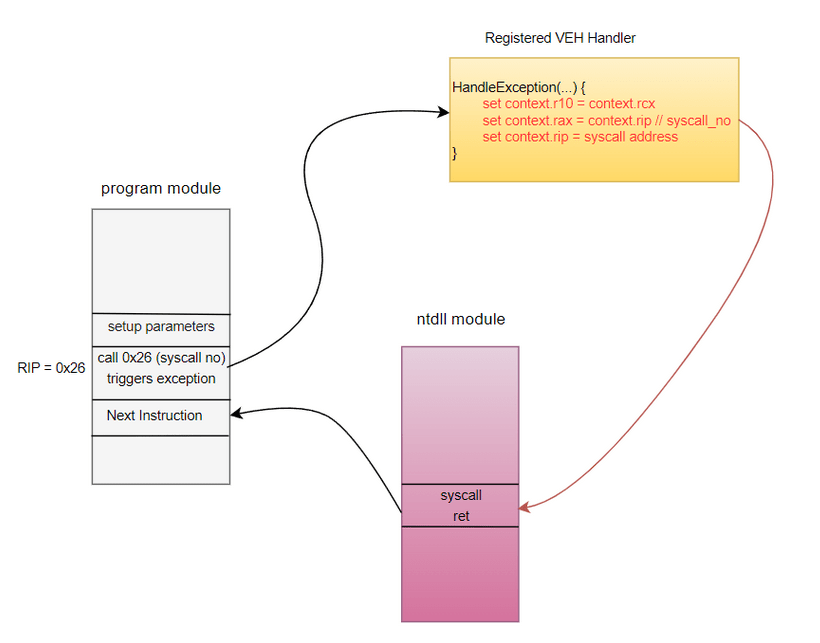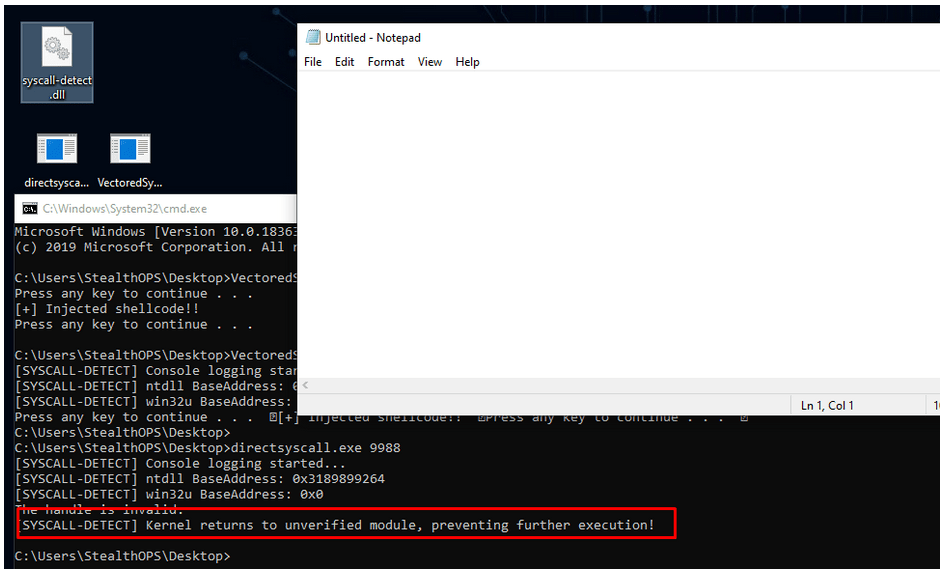Bypassing AV/EDR Hooks via Vectored Syscall - POC
Vectored Syscall
It’s common to unhook any AV/EDRs hook in order to bypass them. However to unhook the AV/EDRs hook we need to call a famous Win32 API VirtualProtect which eventually ended up calling NtVirtualProtectMemory inside ntdll.dll and that might also be hooked by most of the AV/EDRs. Then there comes a technique called Direct Syscall to rescue us from this situation in which the syscall doesn’t go through the ntdll module so the hooks placed in the ntdll module are untouched during the syscall. However, syscalls not originating from ntdll or other known modules are considered suspicious. Direct syscalls can be detected using a technique called hooking nirvana in which instrumentation callback is used.
Every-time the kernel returns to user mode, the RIP register is checked to see if the address pointed by RIP is in a known module address range, otherwise the syscall is crafted manually.
Due to the fact that RIP instruction is checked to detect manual syscall, it can be bypassed by jumping indirectly to the ntdll address space where the syscall instruction is located. However, we’re not going to do that, instead we’ll leverage the VEH (Vectored Exception Handler) to modify the context, especially RIP register to take us to the syscall address.
Note : We will be locating the syscall address manually. Also we’re using VEH for this POC since VEH is the first one to handle the exception when the kernel passes the control to ring3.


Now we’ll define the NT APIs that we’re going to use in this POC. Now we need to initialize the NT APIs. Before that we need to figure out the way to trigger the exception since there are multiple ways to trigger the exception (div by 0, int 3 etc.).
For this POC we’ll go with the access violation exception (there’s a reason for this). Following is the initialization of NT APIs.

We’ve initialized the NT APIs with their syscall number rather than their address and calling this function will cause the exception (EXCEPTION_ACCESS_VIOLATION). Now you might have figured out why we’re initializing the NT APIs with their corresponding syscall number. There’s two reason for doing this:
- Triggering the exception
- Passing the syscall number through RIP instruction to the VEH handler. If we had triggered other exceptions we might need to do extra work to pass the syscall number to the handler.
Whenever the exception occurs the current execution state is saved and execution is transferred to the exception handler; this is done to restore back to the normal execution after the exception is processed. Usually Information are saved in following structures:
- KTRAP_FRAME: Saves the current execution states i.e., contents of CPU registers and others
- EXCEPTION_RECORD: Records information like exception code, exception address, next exception record etc.
Now we need to find the syscall address in the ntdll so that we can modify and set RIP register to syscall address in the vectored handler. There are different ways to do this for this POC, we’ll retrieve the address of a random NT API function and calculate the syscall.

The idea is to traverse through the bytes from the retrieved function base address until we get the sequence of instruction bytes that we’re looking for i.e., syscall instruction following “ret” instruction.




Testing with Direct Syscall. Code is modified to include the “syscall-detect.dll” (from syswhispers), as it will detect the syscall & prevent further program execution. Notepad.exe is used as the case for testing code injection.


Tested on Bitdefender enabled Environment with following manual syscall detection projects:
https://github.com/xenoscr/manual-syscall-detect
https://github.com/jackullrich/syscall-detect
Key Points:
- Since our syscall goes through Ntdll RIP checks in the manual syscall detection is bypassed
- Syscall address is calculated in the memory so we do not need to unhook the AV/EDRs hook
- AddVectoredExceptionHandler call in a normal application looks suspicious on itself, so need to do some more work for stealthy
- Syscall numbers can still be tracked to detect the malicious behavior
- It’s only tested with the Bitdefender so it’s premature to say it’ll work on the other AV/EDRs as well
If you want to learn more about Instrumentation Callback:
https://winternl.com/detecting-manual-syscalls-from-user-mode/
https://blog.xenoscr.net/2022/01/17/x86-Nirvana-Hooks.html
Blog Written by :
John Sherchan, Red Team Security Researcher at CyberWarFare Labs
Proof Read by :
Yash Bharadwaj, CTO CyberWarFare Labs
Stay connected with news and updates!
Join our mailing list to receive the latest news and updates of cutting-edge cyber security research from our team.
Don’t worry, your information will not be shared.


































